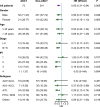Effect of autologous hematopoietic stem cell transplantation for patients with peripheral T-cell lymphoma in China: A propensity score-matched analysis
- PMID: 36465366
- PMCID: PMC9712948
- DOI: 10.3389/fonc.2022.1039888
Effect of autologous hematopoietic stem cell transplantation for patients with peripheral T-cell lymphoma in China: A propensity score-matched analysis
Abstract
Background: The role of consolidation therapy with autologous stem cell transplantation (ASCT) in patients with peripheral T-cell lymphoma (PTCL) in first complete remission (CR1) or partial remission (PR1) remains controversial. The existing data from China are limited. Therefore, we aimed to investigate the effect of ASCT on the survival of Chinese patients with PTCL showing response to induction chemotherapy at our hospital.
Methods: We retrospectively reviewed the data of patients with PTCL (excluding Natural killer/T cell lymphoma) in CR1 or PR1 treated at Peking University Hospital &Institute from 1996 to 2020. Propensity score matching (PSM) was used to balance clinical characteristics between the ASCT and non-ASCT groups. The primary endpoints were event-free survival (EFS) and overall survival (OS).
Results: Of the 414 selected patients, 73 received ASCT consolidation and 341 did not. Over a median follow-up of 5.7 years, survival was significantly better in the ASCT group than in the non-ASCT group (median EFS, 8.1 years vs. 2.8 years, P = 0.002; median OS, 14.9 years vs. 10.2 years, P = 0.007). The 5-year EFS and OS rates were 68.4% and 77.0% in ASCT group, and 43.2% and 57.6% in non-ASCT group, respectively. The survival benefit was confirmed in the propensity score matched cohort (46 patients who received ASCT and 84 patients who did not receive ASCT): P = 0.007 for median EFS and P = 0.022 for the median OS. Cox regression analysis showed that ASCT was independently associated with better survival: hazard ratio (HR) for EFS, 0.46 (95% CI: 0.28-0.76); HR for OS, 0.50 (95% CI: 0.31-0.84). Subgroup analysis showed that ASCT was more likely to benefit higher-risk patients and those with advanced disease. Among the subtypes of PTCL, the benefit was significant in angioimmunoblastic T-cell lymphoma (HR = 0.26 [95% CI: 0.10-0.66] for EFS and 0.29 [95% CI: 0.12-0.74] for OS), but not in the other subtypes.
Conclusion: ASCT may improve the long-term survival of patients with PTCL in first CR or PR, especially for patients with angioimmunoblastic T-cell lymphoma. The specific groups most likely to benefit from upfront ASCT need to be clearly identified.
Keywords: autologous hematopoietic stem cell transplantation (autoHCT); outcomes - health care; peripheral T-cell lymphoma; propensity score matching (PSM); survival.
Copyright © 2022 Gao, Wu, Hu, Ding, Ji, Mi, Wang, Song, Zhu and Liu.
Conflict of interest statement
The authors declare that the research was conducted in the absence of any commercial or financial relationships that could be construed as a potential conflict of interest.
Figures



Similar articles
-
Consolidation therapy with autologous stem cell transplantation after remission of induction chemotherapy prolongs the survival of patients with peripheral T-cell lymphoma.Front Immunol. 2024 May 10;15:1382189. doi: 10.3389/fimmu.2024.1382189. eCollection 2024. Front Immunol. 2024. PMID: 38799461 Free PMC article.
-
The role of autologous stem cell transplantation in patients with nodal peripheral T-cell lymphomas in first complete remission: Report from COMPLETE, a prospective, multicenter cohort study.Cancer. 2019 May 1;125(9):1507-1517. doi: 10.1002/cncr.31861. Epub 2019 Jan 29. Cancer. 2019. PMID: 30694529 Free PMC article.
-
HEMATOPOIETIC STEM CELL TRANSPLANT IN AGGRESSIVE T AND NK/T CELL LYMPHOMA - ROLE OF UPFRONT AUTOLOGOUS TRANSPLANT IN NODAL PERIPHERAL T-CELL LYMPHOMA.Blood Cell Ther. 2021 Nov 25;4(4):92-100. doi: 10.31547/bct-2021-007. eCollection 2021 Nov 25. Blood Cell Ther. 2021. PMID: 36714065 Free PMC article.
-
Peripheral T-cell lymphoma: the role of hematopoietic stem cell transplantation.Crit Rev Oncol Hematol. 2014 Feb;89(2):248-61. doi: 10.1016/j.critrevonc.2013.08.016. Epub 2013 Sep 8. Crit Rev Oncol Hematol. 2014. PMID: 24075060 Review.
-
Role of upfront autologous transplant for peripheral T-cell lymphoma patients achieving a complete remission with first-line therapy: a systematic review and meta-analysis.Bone Marrow Transplant. 2024 Jun;59(6):838-848. doi: 10.1038/s41409-024-02254-x. Epub 2024 Mar 5. Bone Marrow Transplant. 2024. PMID: 38443704
Cited by
-
Consolidation therapy with autologous stem cell transplantation after remission of induction chemotherapy prolongs the survival of patients with peripheral T-cell lymphoma.Front Immunol. 2024 May 10;15:1382189. doi: 10.3389/fimmu.2024.1382189. eCollection 2024. Front Immunol. 2024. PMID: 38799461 Free PMC article.
-
Application patterns and outcomes of hematopoietic stem cell transplantation in peripheral T-cell lymphoma patients: a multicenter real-world study in China.Exp Hematol Oncol. 2024 Aug 24;13(1):88. doi: 10.1186/s40164-024-00557-9. Exp Hematol Oncol. 2024. PMID: 39182130 Free PMC article.
References
LinkOut - more resources
Full Text Sources
Research Materials
Miscellaneous

